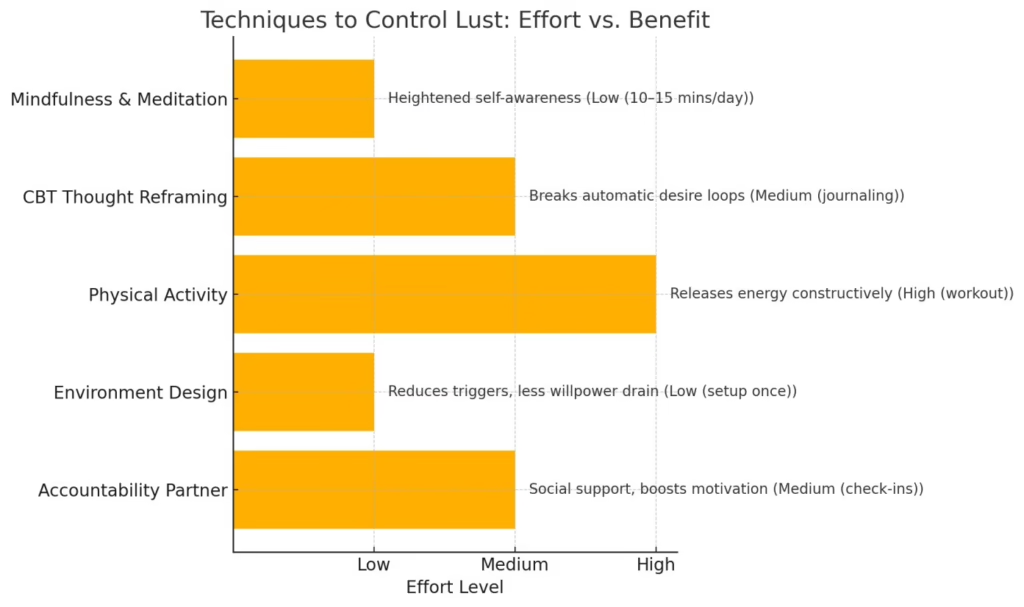Reclaim Your Power to Control Lust
Lust is a force as old as humanity—but as men striving for purpose, learning to control lust can unlock untapped energy for our goals. Imagine redirecting that rush of desire into creative projects, workouts, or deep connections with others. In this post, you’ll discover research-backed techniques, personal insights, and fresh perspectives on how to control lustful thoughts, so you can kill lust before it kills your productivity.
Understanding Lust: Biology Meets Psychology
Lust triggers a cascade of neurotransmitters—dopamine surges, testosterone spikes, and the brain’s reward centers lighting up with every tantalizing thought. Yet, uncontrolled, those same pleasures can derail long-term aspirations. Recognizing lust as both natural and manageable is the first step toward mastery.
- Neurochemistry: Sexual desire lights up the brain’s ventral tegmental area, mirroring addiction pathways.
- Hormonal Drivers: Testosterone variations amplify desire; practicing self-control temporarily stabilizes these swings.
- Mind–Body Connection: Physical sensations feed mental loops—breaking one breaks the other.
Indulgence vs. Discipline
| Aspect | Indulgence | Discipline |
|---|---|---|
| Immediate Effect | Quick gratification, fleeting pleasure | Delayed reward, growing self-confidence |
| Long-Term Impact | Guilt, energy drain | Enhanced focus, emotional resilience |
| Energy Allocation | Channels toward sexual release | Redirects to creativity, career, relationships |
| Self-Perception | Passive victim of urges | Active architect of destiny |
Why Men Struggle to Suppress Lust
Psychological Triggers
- Environmental Cues: Late-night scrolling or provocative media spark impulses. Kentucky Counseling Center
- Stress & Boredom: When the mind lacks other outlets, sexual thoughts fill the void.
Biological Factors
- Hormonal Swings: Peaks in testosterone can make resistence feel almost impossible.
- Neural Conditioning: Frequent indulgence strengthens the “lust habit loop,” making relapses common.
Emotional Roadblocks
- Loneliness & Shame: Feelings of isolation often intensify urges—and subsequent guilt.
- Unrealistic Expectations: The belief that total abstinence means never thinking about sex can backfire.
5 Evidence-Based Strategies: To Control Your Lust
1. Mindfulness & Meditation
Research shows mindfulness blunts impulsive sexual urges by increasing awareness of bodily sensations and thoughts. Practicing just 10 minutes daily can create a mental “pause button” between desire and action Marriage.com.
- Quick Tip: When an urge hits, pause, breathe deeply, and label the sensation (“thinking,” “feeling,” “desire”).
2. Cognitive Behavioral Techniques (CBT)
Reframe intrusive thoughts by challenging their validity. Ask yourself: “Will yielding to this urge help me reach my goals?” This simple self-question interrupts the automatic lust loop and reasserts control.
- Thought Log: Write down triggers, emotions, and alternative actions. Over time, patterns emerge—powerful intel for change.
3. Physical Activity & Energy Channeling
Channel sexual energy into exercise, creative hobbies, or service. Studies link regular workouts to lower intrusive sexual thoughts Verywell Mind.
- Energy Channeling: Schedule a workout, piano practice, or community project when urges peak (often late afternoon).
4. Environmental Design: Kill Temptations
Modify your surroundings:
- Content Filters: Use website blockers or NSFW filters on devices.
- Non-Trigger Spaces: Create “safe zones” (e.g., your office or gym) where lustful cues are minimal. My Wellness Hub
5. Accountability & Support
Join a brotherhood—whether a trusted friend, mentor, or online community (e.g., NoFap). Regular check-ins and honest sharing keep motivation high and guilt low.
Personal Anecdote: My Journey to Mastering Self-Control
In my early 20s, I faced daily battles with intrusive lustful thoughts that zapped my focus. I tried sheer willpower—and failed. Then I combined meditation with energy channeling: a 15-minute midday mindfulness break, followed by a brisk walk or writing session. Within weeks, urges became manageable. Today, those same energy surges fuel my most creative work.
The Science of Self-Control: Building Your Self-Control Muscle
Renowned psychologist Roy Baumeister likens willpower to a muscle: it fatigues but also grows stronger with regular exercise Wikipedia. By consistently practicing small acts of discipline, you expand your capacity to control lust—and every other impulse.
5 Steps to Suppress Lust

Comparison of Techniques
| Technique | Benefit | Effort Level |
|---|---|---|
| Mindfulness & Meditation | Heightened self-awareness | Low (10–15 mins/day) |
| CBT Thought Reframing | Breaks automatic desire loops | Medium (journaling) |
| Physical Activity | Releases energy constructively | High (workout) |
| Environment Design | Reduces triggers, less willpower drain | Low (setup once) |
| Accountability Partner | Social support, boosts motivation | Medium (check-ins) |
Conclusion: Your Path to Mastery
Learning how to control your lust isn’t about denial—it’s about redirection. By combining mindfulness, CBT, physical activity, environment tweaks, and a strong support system, you transform lust from a weakness into a wellspring of creative power. Start small, stay consistent, and watch your self-control muscle grow stronger every day.
Call-to-Action
Which strategy will you implement first? Share your thoughts below and join our 30-Day Energy Channeling Challenge!
🔗 Explore more: Harnessing Energy for Success | Building Lasting Habits
👉 Subscribe for weekly insights on self-mastery and growth mindset.



